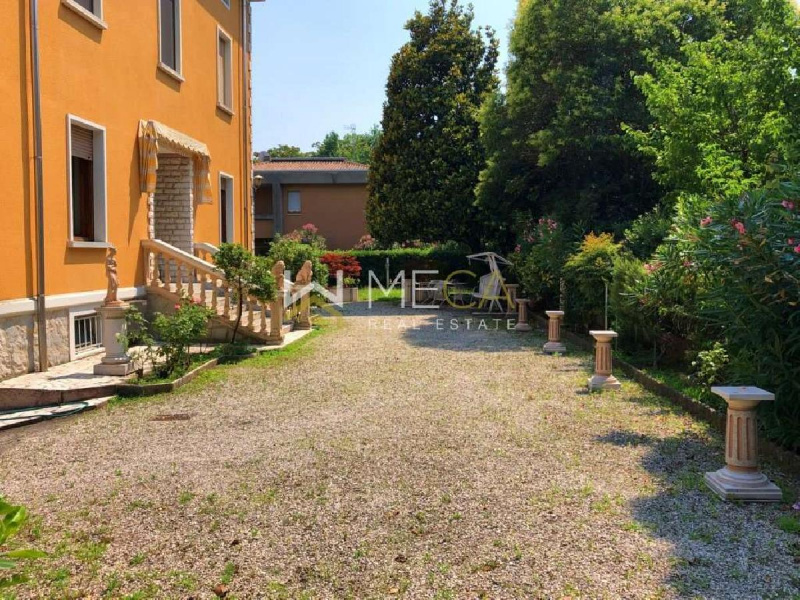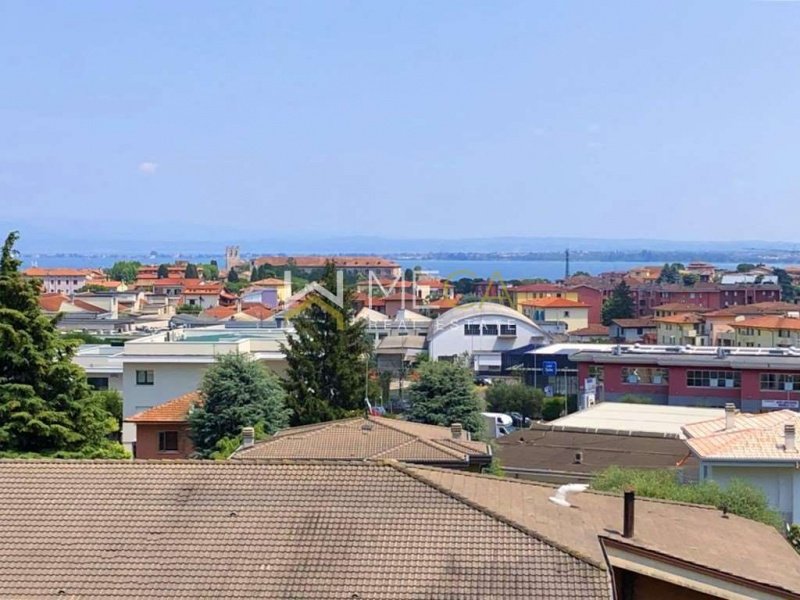Desenzano del Garda, prestigious villa built in the beginning of the last century with suggestive liberty finishes and architectural reliefs from the period, very important and refined, renovated in the 60s.
Surrounded by an elegant private garden of about 800 square meters, on which, with authorization, there is ample space to possibly create a swimming pool surrounded by several statues present which contribute to creating a fascinating atmosphere, the context is also supported by a partial and pleasant lake view, which can also be enjoyed from the interior of the villa, from which the upper floors can admire the lake and the Veronese coast
Excellent solution with double driveway, the villa is structured on 4 floors:
Basement with garage, technical rooms and cellar;
Ground floor with large living area, kitchen, 2 double bedrooms;
First floor recently renovated of the same size and layout as the ground floor,
The two main floors each have their own independent entrance and are completely autonomous, each with its own boiler, important characteristics if two families keep alive in the same way, leaving them totally independent.
Large attic and a particular tower that gives a touch of further charm to the property.
Excellent solution, important and prestigious, to be restored clearly but with which restructuring you can get a pearl of exceptional value in the center of Desenzano.
Lake Garda
Lake Garda or Benaco is the largest Italian lake, with an area of approximately 370 km² (third in depth after Como and Maggiore). Hinge between three regions, Lombardy (province of Brescia), Veneto (province of Verona), Trentino-Alto Adige (province of Trento), it is placed in parallel with the Adige, from which it is divided by the Monte Baldo massif. To the north it is narrow funnel while in the south it widens, surrounded by morainic hills that make the landscape sweeter. The lake is an important tourist destination and is visited by millions of people every year. In Roman times the lake was known as Benacus and by some it was revered as god Benacus, personification of the lake itself, sometimes associated with the cult of the god Neptune. Today it is better known as Lake Garda, a toponym attested since the Middle Ages and of Germanic origin, deriving from that of the town of the same name on the Veronese side of the lake, which, together with another famous lake town, Gardone Riviera, and others less known, such as Gàrdola, Gardoncino, Gardoni, Guàrdola and Le Garde, testifies to the Germanic presence that goes from the VI to the VIII century, in particular the Lombard one. The toponym Garda, with which the lake is already called in some documents of the eighth century, is the evolution of the Germanic voice warda, or “place of guard” or “place of observation”. The classic toponym of the lake, or Benācus lacus (Benaco), is almost certainly of Celtic origin, therefore prior to the Roman dominion, and should derive from bennacus, comparable with the Irish bennach, and would mean “horned”, or by the many promontories. The translation “cornuto” is also interpreted in reference to the Sirmione peninsula. The Latin voice of Benaco is attested as Benācus, -i and therefore presupposes a flat accent (Benàco): the Italian version of the tonic accent remains faithful to the Latin accent, therefore it must be pronounced with the accent on the “a”. The inhabitants of the lake, especially those of the Veronese shore, pronounce the name Benaco with the accent on the “e”, or Bènaco. The reason why the natives of the lake areas tend to use the version with the slippery accent of the name remains unclear.
自动翻译所用的语言
Desenzano del Garda, prestigiosa villa di inizio secolo scorso con suggestive finiture liberty e rilievi architettonici de periodo, molto importante e raffinata, ristrutturata negli anni '60.
Circondata da un elegante giardino privato di circa 800 mq, sul quale, previa autorizzazione, c'è ampio spazio per eventualmente realizzare una piscina circondata da diverse statue presenti che contribuiscono a creare un'affascinante atmosfera, il contesto inoltre è avvalorato da una parziale e gradevole vista lago, della quale si puó godere anche dagli ambienti interni della villa, dai quali piani superiori i puó ammirare il lago e la costa veronese
Soluzione eccellente con doppio ingresso carrabile, la villa si struttura su 4 piani :
Interrato con box auto, locali tecnici e cantina;
Piano terra con ampia zona giorno, cucina abitabile, 2 camere matrimoniali;
Piano primo ristrutturato recentemente della stessa dimensione e disposizione del piano terra,
I due piani principali hanno ciascuno il proprio ingresso indipendente e sono completamente autonomi, ognuno con la propria caldaia, caratteriistiche importanti se due nuclei familiari vigliono vivere assime rimandendo totalmente indipendenti.
Sottotetto ampio e una particolare torretta che dona un tocco di ulteriore fascino alla proprietà.
Ottima soluzione, importante e prestigiosa, da ristrutturare chiaramente ma con la quale ristrutturaizione si puó ottenere una perla di eccezionale valore in pieno centro a Desenzano.
Il lago di Garda
Il lago di Garda o Benaco è il maggiore lago italiano, con una superficie di circa 370 km² (terzo per profondità dopo Como e Maggiore). Cerniera fra tre regioni, Lombardia (provincia di Brescia), Veneto (provincia di Verona), Trentino-Alto Adige (provincia di Trento), è posto in parallelo all'Adige, da cui è diviso dal massiccio del monte Baldo. A settentrione si presenta stretto a imbuto mentre a meridione si allarga, circondato da colline moreniche che rendono più dolce il paesaggio. Il lago è un'importante meta turistica ed è visitato ogni anno da milioni di persone.
In epoca romana il lago era conosciuto come Benacus e da alcuni era venerato come dio Benacus, personificazione stessa del lago, talvolta associata al culto del dio Nettuno. Oggi è meglio noto come lago di Garda, toponimo attestato fin dal Medioevo e di origine germanica, derivante da quello dell'omonima cittadina sulla sponda veronese del lago, la quale, insieme a un'altra località celebre del lago, Gardone Riviera, e altre meno conosciute, come Gàrdola, Gardoncino, Gardoni, Guàrdola e Le Garde, testimonia la presenza germanica che va dal VI all'VIII secolo, in particolare quella longobarda. Il toponimo Garda, con il quale è chiamato il lago già in alcuni documenti dell'VIII secolo, è l'evoluzione della voce germanica warda, ovvero “luogo di guardia” o “luogo di osservazione”. Il toponimo classico del lago, ovvero Benācus lacus (Benaco), è quasi sicuramente di origine celtica, precedente quindi al dominio romano, e dovrebbe derivare da bennacus, confrontabile con l'irlandese bennach, e significherebbe “cornuto”, ovvero dai molti promontori. La traduzione “cornuto” viene anche interpretata in riferimento alla penisola di Sirmione.
La voce latina di Benaco è attestata come Benācus, -i e presuppone quindi un accento piano (Benàco): la versione italiana dell'accento tonico rimane fedele all'accentazione latina, quindi va pronunciato con l'accento sulla “a”. Gli abitanti del lago, in particolar modo quelli della sponda veronese, pronunciano il nome Benaco con l'accento sulla “e”, ovvero Bènaco. Resta oscuro il motivo per cui i nativi delle zone del lago tendono ad utilizzare la versione con l'accento sdrucciolo del nome.
CLASSE ENERGETICA: G
Desenzano del Garda, eine prestigeträchtige Villa, die zu Beginn des letzten Jahrhunderts erbaut wurde und suggestive Freiheitsabschlüsse und architektonische Reliefs aus dieser Zeit aufweist, sehr wichtig und raffiniert, in den 60er Jahren renoviert.
Umgeben von einem eleganten privaten Garten von ca. 800 Quadratmetern, auf dem mit Genehmigung ausreichend Platz vorhanden ist, um möglicherweise ein Schwimmbad zu schaffen, das von mehreren vorhandenen Statuen umgeben ist, die zur Schaffung einer faszinierenden Atmosphäre beitragen, wird der Kontext auch durch ein partielles und unterstützt angenehmer Blick auf den See, den Sie auch vom Inneren der Villa aus genießen können, von wo aus die oberen Stockwerke den See und die veronesische Küste bewundern können
Hervorragende Lösung mit doppelter Auffahrt, die Villa ist auf 4 Etagen strukturiert:
Keller mit Garage, Technikräumen und Keller;
Erdgeschoss mit großem Wohnbereich, Küche, 2 Doppelzimmern;
Erster Stock vor kurzem renoviert in der gleichen Größe und Anordnung wie das Erdgeschoss,
Die beiden Hauptetagen haben jeweils einen eigenen, unabhängigen Eingang und sind völlig autonom, jeder mit einem eigenen Kessel. Dies sind wichtige Merkmale, wenn zwei Familien auf die gleiche Weise am Leben bleiben und somit völlig unabhängig bleiben.
Großer Dachboden und ein besonderer Turm, der dem Anwesen einen Hauch von weiterem Charme verleiht.
Hervorragende Lösung, wichtig und prestigeträchtig, um klar restauriert zu werden, aber mit welcher Umstrukturierung erhalten Sie eine Perle von außergewöhnlichem Wert im Zentrum von Desenzano.
Gardasee
Der Gardasee oder Benaco ist mit einer Fläche von ca. 370 km² der größte italienische See (dritter in der Tiefe nach Como und Maggiore). Es liegt zwischen drei Regionen, der Lombardei (Provinz Brescia), Venetien (Provinz Verona) und Trentino-Südtirol (Provinz Trient). Es liegt parallel zur Etsch, von der es durch das Monte-Baldo-Massiv getrennt ist. Im Norden ist es ein schmaler Trichter, während er sich im Süden erweitert, umgeben von morainischen Hügeln, die die Landschaft süßer machen. Der See ist ein wichtiges Touristenziel und wird jedes Jahr von Millionen von Menschen besucht.
In der Römerzeit war der See als Benacus bekannt und wurde von einigen als Gott Benacus verehrt, eine Personifikation des Sees selbst, die manchmal mit dem Kult des Gottes Neptun in Verbindung gebracht wurde. Heute ist es besser bekannt als der Gardasee, ein seit dem Mittelalter bezeugtes Toponym germanischen Ursprungs, das sich von der gleichnamigen Stadt auf der veronesischen Seite des Sees ableitet, die zusammen mit einer anderen berühmten Seestadt, der Gardone Riviera und andere weniger bekannte, wie Gàrdola, Gardoncino, Gardoni, Guàrdola und Le Garde, zeugen von der germanischen Präsenz, die vom VI bis zum VIII. Jahrhundert reicht, insbesondere von der lombardischen. Das Toponym Garda, mit dem der See bereits in einigen Dokumenten des 8. Jahrhunderts genannt wird, ist die Entwicklung der germanischen Stimme warda oder „Ort der Wache“ oder „Ort der Beobachtung“. Das klassische Toponym des Sees oder Benācus lacus (Benaco) ist mit ziemlicher Sicherheit keltischen Ursprungs, daher vor der römischen Herrschaft, und sollte von bennacus abgeleitet sein, vergleichbar mit dem irischen bennach, und würde „gehörnt“ oder von der bedeuten viele Vorgebirge. Die Übersetzung „cornuto“ wird auch in Bezug auf die Halbinsel Sirmione interpretiert.
Die lateinische Stimme von Benaco wird als Benācus -i attestiert und setzt daher einen flachen Akzent (Benàco) voraus: Die italienische Version des tonischen Akzents bleibt dem lateinischen Akzent treu, daher muss sie mit dem Akzent auf dem „a“ ausgesprochen werden. Die Bewohner des Sees, insbesondere die des veronesischen Ufers, sprechen den Namen Benaco mit dem Akzent auf dem „e“ oder Bènaco aus. Der Grund, warum die Eingeborenen der Seegebiete dazu neigen, die Version mit dem rutschigen Akzent des Namens zu verwenden, bleibt unklar.


